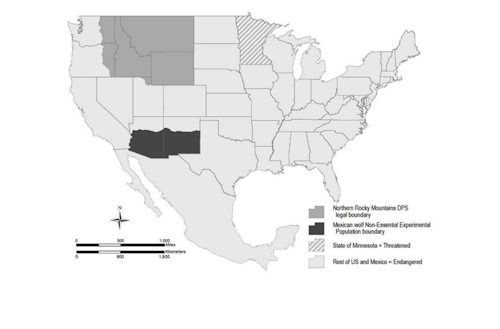In the roller-coaster ride that defines gray wolf management in the Lower 48 states, the 2020 delisting of the apex predator in the Great Lakes region (Michigan, Minnesota and Wisconsin) and beyond has once again been reversed. Following a February 10, 2022, court order, gray wolves in the contiguous 48 states and Mexico – with the exception of the northern Rocky Mountain population – are now protected under the Endangered Species Act (ESA) as threatened in Minnesota and endangered in the remaining states. Critical habitat for gray wolves in Minnesota and Michigan and the 4(d) rule for gray wolves in Minnesota are also reinstated.
In what’s beginning to resemble a ping pong game, California U.S. District Judge Jeffrey S. White ruled in favor of a lawsuit filed by the Humane Society of the United States and other “conservation” organizations against the U.S. Department of the Interior in January 2021, reversing a 2020 U.S. Fish and Wildlife Service (FWS) rule that removed wolves from the list in 45 states. Wolves were also relisted in the Great Lakes Region in 2014, after being removed from the list of endangered and threatened species in 2012.
So, what does this mean for wolf management in the Lower 48 states? The following is an informational Questions and Answers posting from the U.S. Fish & Wildlife Service that provides an outlook of what wolf management will look like going forward — at least for now.
What Does the February 10, 2022, Ruling Mean?
Because the court vacated the U.S. Fish and Wildlife Service’s 2020 final delisting rule, gray wolves outside the Northern Rocky Mountain population (see map below) are now protected under the Endangered Species Act (ESA) as threatened in Minnesota and endangered in the remaining states. Critical habitat for gray wolves in Minnesota and Michigan and the 4(d) rule for gray wolves in Minnesota are also reinstated. Thus, any take (harass, harm, pursue, hunt, shoot, wound, kill, trap, capture or collect, or to attempt to engage in any such conduct) of wolves without a permit or other authorization is prohibited by federal law.
How Does This Ruling Affect Wolves in the Northern Rocky Mountains?
This ruling does not affect the listing status of wolves in the Northern Rocky Mountain population, and they remain under state management. Those wolves have been delisted since 2011 (Idaho and Montana) and 2017 (Wyoming) and are no longer protected by the ESA.
When Does the Court Decision to Vacate the Delisting Rule Go into Effect?
The court’s decision on the 2020 gray wolf delisting rule was effective immediately when it was issued on February 10, 2022. Thus, all gray wolves in the contiguous 48 states and Mexico — with the exception of the Northern Rocky Mountain population — are now under the protection of the ESA.
What is the Legal Status of Gray Wolves as of This Ruling?
Gray wolves are now listed in every state in the Lower 48, with the exception of the Northern Rocky Mountain population in Idaho, Montana, Wyoming and parts of Oregon and Washington state and northcentral Utah. Wolves have never been listed in Alaska. The court’s decision is specific to the gray wolf and does not include the separate listings of the Mexican wolf subspecies and the red wolf species.
Is the Service Continuing Its Status Review of Wolves in the western United States?
The Service is currently evaluating the status of gray wolves in the western United States, including the northern Rocky Mountains, to determine whether ESA protection is again warranted for those wolves. In the course of that review, the Service will assess whether the recent changes in state management are adequate to ensure that wolves in the western United States are sustained at a healthy and secure population level. We are currently evaluating how the February 10, 2022, district court opinion and the relisting of gray wolves might affect the status review. Information on the listing process under the ESA is available online: https://www.fws.gov/endangered/esa-library/pdf/listing.pdf.
Is Emergency Listing an Option for the Northern Rocky Mountain Population?
The Service has the ability to act swiftly to protect gray wolves in the northern Rocky Mountains if there is an emergency posing a significant risk to the well-being of the species. In such an emergency, the Service can immediately list the species for 240 days. We are closely monitoring data on wolf populations in the northern Rocky Mountain states based on the best available science.
Are Wolf Hunts Going to Stop as a Result of the Court Decision?
Effective immediately, wolf hunts are no longer allowed in states from the 2020 delisting rule, including the Great Lakes states (Michigan, Minnesota and Wisconsin). States in the northern Rocky Mountains (i.e., Montana, Idaho and Wyoming) will continue to manage wolves and wolf harvest (to include hunting and trapping) according to state laws and respective gray wolf management plans.
How Does This Ruling Affect Wolves in Yellowstone National Park?
Yellowstone National Park is located in Wyoming, Idaho and Montana. Therefore, this rule does not affect wolves in Yellowstone National Park. The National Park Service retains all management of gray wolves within the park boundary. The surrounding states will continue to manage gray wolves according to state laws and respective gray wolf management plans when outside the park boundary.
Where Can More Information Be Found?
For more background, visit: https://www.fws.gov/home/wolfrecovery/.







